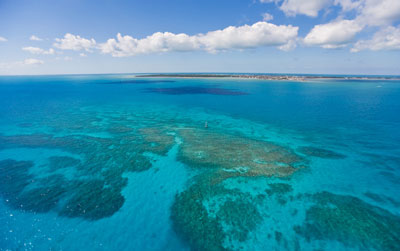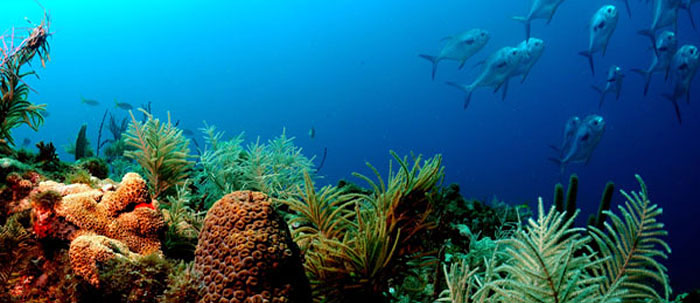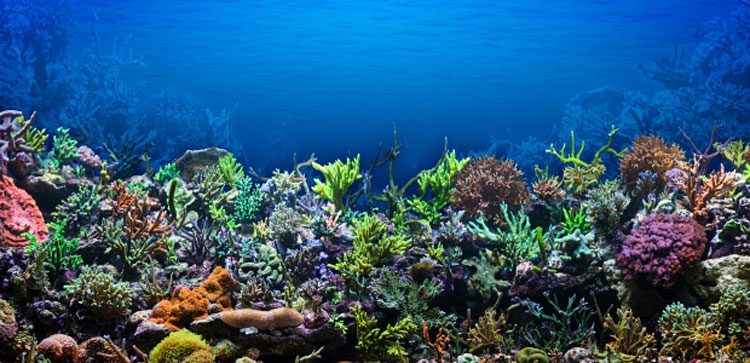Florida’s Coral Reef’s are the only reefs that belong to the continental United States of America. After the Great Barrier Reef and the Belize Barrier Reef, it is the third largest reef system in the world.

There are over 6,000 reefs in the Florida Reef system, sharing this designation with Cuba’s coral reefs and the Abaco coral reefs of the Bahamas.
Florida’s Coral Reefs lie about four miles from the Florida Keys. They are about four miles wide and are dispersed all throughout the waters here, as you aproach the deeper waters seaward.
Florida’s coral reefs are estimated to be 5,000 to 7,000 years old and were formed some time after thelast ice age, which was called the Wisconsian glaciation.

Of the three types of reefs: fringing, atoll, and barrier, most of Florida’s reefs would be classified as barrier reefs. However, they lack the kinds of shallow lagoons one typically finds in barrier reef systems. Therefore, Florida’s reefs are called “bank reefs” and the other scattered reefs around are called “patch reefs.” These patch reefs are very small – the size of a small house.
The most common corals found in Florida’s reefs are brain, elkhorn, star, and staghorn corals. Each has its own unique structure. Brian corals resemble the human brain and are circular with ridges and folds on them. Star corals are dome-shaped as well, but they have a star shape on the dome. Both elkhorn and staghorn reefs have antler-shapes that extend outward.
Different Colonies, Each With Its Own Coral Species
The Florida Reefs are interesting in that they are all formed into different colonies, each with its own type of coral. Therefore, since there are 45 species of hard, “stony” corals here, and 37 species of soft corals, or “octorals” (basically sea fans and other soft formations), there are 45 individual colonies of reefs here, each with one species of stony coral with soft octorals within and among them.
Each coral reef colony is a distinctive color because the coral takes on the hues of the algae that live inside them. Scuba divers can visit each coral colony as if they are discovering a new city, each with its own distinctive personality, so to speak.
Species of Fish, Turtles, and Other Marine Life in the Florida Reef
The Florida reefs are also home to filefish, schools of gobies, blennies, pufferfish, butterfly fish, parrotfish, angel fish, jewfish, tarpon, grouper, and the huge Goliath grouper that can weigh as much as 790 pounds and grow to some 16 feet long. Moray eels and snake eels are also frequently spotted
Huggable, Kissable Wrasses
There are over a thousand species of fish and other marine life in the Florida Reefs – colorful, distinctive fish like the hawksbill turtles, huge, friendly wrasses with the great kissable big lips. Wrasses, of course, are beloved by snorkelers and divers everywhere because these fish are so friendly you can kiss and hug them.
Beautiful and Abundant Sea Turtles – Including the Oliver Ridley
Green turtles and loggerhead turtles are abundant in the Florida reefs. Most divers, however, hope to catch a glimpse of the tiniest, rarest turtle in the world—the Kemp’s Ridley, which sometimes can be seen in Florida Reef waters. ‘
The Florida Reef’s Kemp’s Ridley Turtle is the most endangered sea turtle on earth and is possibly the most endangered animal today in existence – with only 1,000 of these tiny turtles still surviving in the entire world.

One reason lies in the fact that these turtles have a mast nesting period in which they come on shore to lay their eggs, then the teeny tiny babies have to make it to shore and swim away. Some are eaten by birds or other animals. Some die from failure to thrive or failure to make the exhausting journey to short.
But the true for their disappearance of this turtle is from over-harvesting of their eggs, and, therefore, human beings are, again to blame.
Sharks in Florida’s Reefs
Surprisingly, Florida’s Reefs are populated by more sharks than any other area in the entire world, which might give some people pause. But these sharks are chiefly timid, non-threatening sharks.
In Florida’s reefs you can see dusky sharks, bull sharks, tiger sharks, hammerhead sharks, nurse sharks, mako sharks, black-tipped sharks, reef sharks, and lemon sharks – quite an exhaustive list, yes?
Florida’s Reefs Need Protection
Tourists and Resident Visitors Touching Reefs, Causing Infections
There are several major threats to Florida’s Coral Reefs. The most pervasive threast is from mankind—chiefly tourists, divers, and snorkelers—all who try to touch the reefs. One small brush from the human hand can break off corals and, despite admonitions, many people keep touching the reefs. Even the touch of someone’s scuba equipment can cause bacterial infection that will destory reefs that are hundreds of thousands years old.

Anchoring
Every time an anchor drops near the reefs, reefs are damaged and, once damaged, are taken over by what is called “nuisance algae” that takes over, causing infection and disease that eventually destroys the reefs.
Water Quality Decline, Turning these Once Beautiful Reefs Brown
Water quality decline is the number one threat to Florida’s reefs, chiefly through run off of dangerous fertilizers and sewage. These pollutants spawn things called algal blooms which compete with the reefs for habitat and oxygen in the water.
All of these stressors are causing huge chunks of disease in the reefs that is turning Florida’s reefs black and brown with infection. Scientists have now noted, also, what they are calling a “Stage shift” in these reefs, wherein soft corals are being replaced by hard ones.
